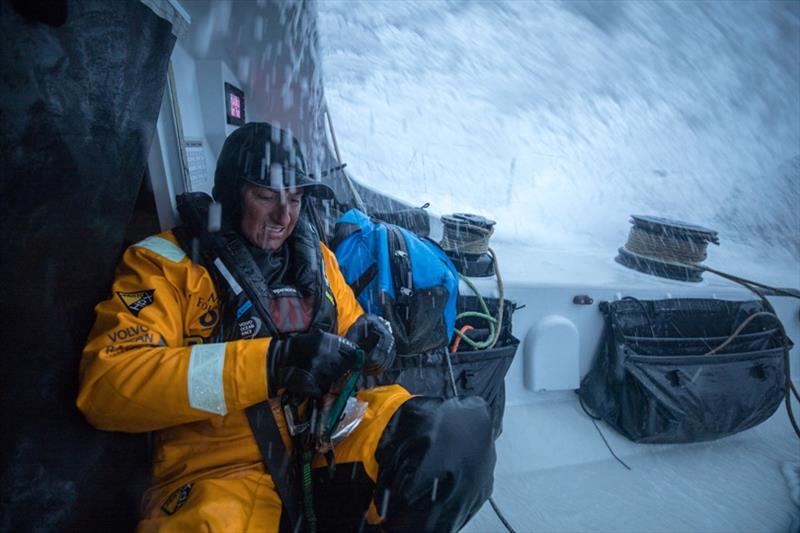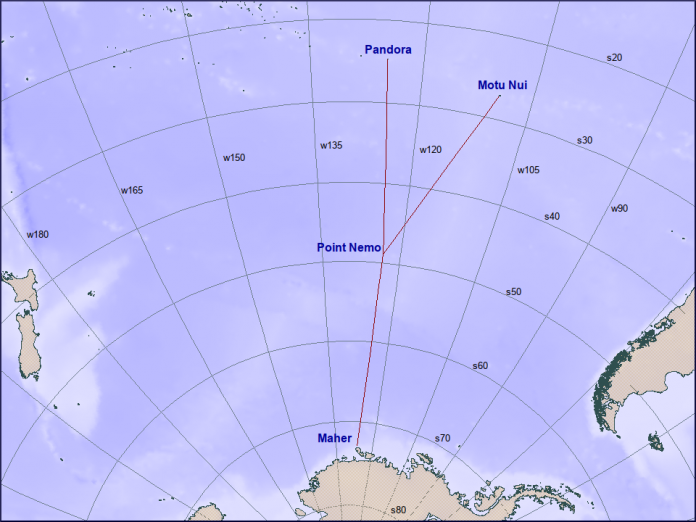Point Nemo, also known as the Oceanic Pole of Inaccessibility, is the point on Earth that is farthest from any land. It is located in the South Pacific Ocean and is considered the most remote and isolated place on the planet.
The exact coordinates of Point Nemo are approximately 48°52.6′S latitude and 123°23.6′W longitude. Point Nemo, though conceptually understood, was officially identified and calculated by Croatian-Canadian survey engineer Hrvoje Lukatela in 1992. He used advanced geo-spatial computer programs to determine its precise location. Interestingly, Lukatela didn’t physically visit the spot; instead, he employed technology to make this calculation. His insight was based on the understanding that, in three-dimensional space, the furthest point from any coastline on Earth must be equidistant from three distinct shorelines. This revelation led to the official establishment of Point Nemo as the oceanic pole of inaccessibility.
Point Nemo got its name from Jules Verne’s Captain Nemo, a fictional character who commanded the Nautilus in “20,000 Leagues Under the Sea”. It’s fitting as this point is the furthest from land and the closest thing we have to the mysterious depths explored in Verne’s novel.
It’s often referred to as the “oceanic pole of inaccessibility”. This means it’s the oceanic point that’s hardest to reach due to its extreme isolation.The closest land to Point Nemo is over 2,688 kilometers (1,450 nautical miles) away. This includes various uninhabited islands like Ducie Island (part of the Pitcairn Islands), Motu Nui (part of the Easter Island chain), and Maher Island (part of Antarctica).
One unique aspect of Point Nemo is that it is a “spacecraft cemetery.” This means that it’s the designated location where defunct spacecraft, such as satellites and space stations, are often deorbited to ensure they don’t pose a risk to other satellites or to populated areas.
Several spacecraft and satellites have been intentionally deorbited to re-enter Earth’s atmosphere over Point Nemo. Some notable examples include:
Mir Space Station (2001): The Russian space station Mir was one of the most significant objects to be deorbited over Point Nemo. After 15 years in orbit, it was deliberately deorbited and re-entered Earth’s atmosphere on March 23, 2001.
Progress M-34 (2001): This was an uncrewed Russian cargo spacecraft that was deorbited over Point Nemo on December 24, 2001.
Space Shuttle Columbia (2003) The tragic Space Shuttle Columbia disaster in 2003 resulted in the orbiter breaking apart during re-entry. The debris fell into the Pacific Ocean, some distance north of Point Nemo.
International Space Station (Various): The ISS periodically conducts deorbit burns to adjust its orbit. While not every adjustment targets Point Nemo, some of them pass relatively close.
These are just a few examples, and there have been many other smaller satellites and spacecraft intentionally deorbited over Point Nemo. It’s worth noting that these deorbits are carefully planned to ensure the debris burns up upon re-entry and doesn’t pose a risk to inhabited areas.
Because of its extreme isolation, the nearest human inhabitants to Point Nemo are usually astronauts aboard the International Space Station (ISS) when it passes overhead. The ISS orbits at an average altitude of about 408 kilometers, which is closer to Point Nemo than any inhabited land.This makes Point Nemo one of the few places on Earth where humans are farther away from any civilization than those in space.
Interestingly, Point Nemo isn’t marked on regular maps. It’s more of a calculated point based on its geographical coordinates.

The Volvo Ocean Race, known for its extreme challenges, has brought sailors past the iconic Point Nemo, often considered the loneliest point on Earth. This occurrence took place during Leg 7 of the race, highlighting the race’s remarkable global reach and the exceptional skills of the participating sailors. This event took place in March 2018
Due to its isolation, marine life around Point Nemo is believed to be quite diverse. It’s a region of the ocean relatively untouched by human activity.
The antipode (directly opposite point on Earth’s surface) of Point Nemo is a desolate region in Eurasia, far from any significant population center.
These facts add to the mystique and fascination surrounding Point Nemo. It’s a location that’s intriguing not just due to its extreme isolation, but also because of its connection to literature and space exploration.
Other points of extreme inaccessibility include the Eurasian Pole in China, as well as the Southern Pole of Inaccessibility in Antarctica. These locations pose significant challenges for visitors due to their remote and demanding environments.
Overall, Point Nemo is a fascinating and significant location, both in terms of its geographical isolation and its role in space exploration and satellite disposal.
